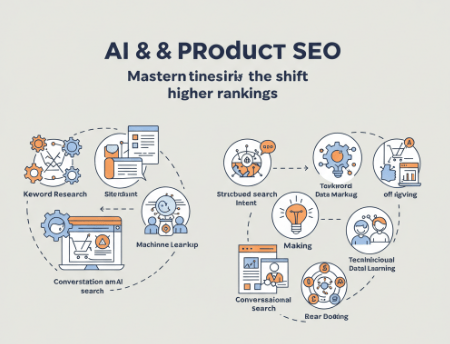The digital marketplace, once a predictable landscape of keywords and backlinks, is now a dynamic ecosystem shaped by artificial intelligence. This isn't just a minor tweak; it's a seismic shift demanding a fundamental re-evaluation of product SEO strategies. AI's influence extends far beyond simple automation, impacting how search engines understand user intent, personalize experiences, and ultimately, determine product visibility.
Understanding the AI Algorithm's Lens:
AI algorithms are no longer mere keyword matchers. They dissect user behavior, analyze semantic relationships, and even interpret visual content with remarkable precision.
Behavioral Analysis: AI tracks user search history, browsing patterns, and purchase behavior, creating detailed profiles that inform personalized search results. This means a product listing optimized for a specific demographic might not rank as highly for another.
Semantic Understanding: AI analyzes the context and intent behind search queries, going beyond literal keyword matching. Search engines now understand the nuanced relationships between words and phrases, rewarding content that answers user questions comprehensively.
Visual Interpretation: Image recognition technology allows AI to analyze visual content, extracting information from product images and videos. This necessitates detailed alt text, descriptive file names, and visually compelling product presentations.
Product SEO Dos: Embracing AI's Potential:
AI-Driven Keyword Intelligence:
Utilize AI tools to uncover long-tail keywords, understand the semantic context of user searches, and analyze competitor keyword strategies. This allows you to capture niche audiences and optimize for intent.
Semantic Content Mastery:
Create comprehensive product descriptions that answer user questions and provide valuable context. Focus on natural language and semantic relationships, demonstrating expertise and authority.
Personalized Product Experiences:
Implement AI-powered recommendation engines to suggest related products, enhancing user engagement and driving sales. Utilize targeted advertising based on user demographics and behavior to maximize campaign effectiveness.
Visual SEO Optimization:
Use AI tools to generate detailed alt text, captions, and descriptions for product images and videos. Optimize visual content for search engines by ensuring relevant metadata and file names.
Data-Driven User Insights:
Employ AI analytics to track user behavior, identify patterns, and gain insights into customer preferences. Use these insights to refine product listings, improve user experience, and optimize marketing strategies.
Schema Markup Enhancement:
Use AI tools to generate and implement structured data, specifically schema markup. Utilize schema types such as Product, Review, and Aggregate Rating. This helps search engines understand product information, leading to rich snippets and increased visibility.
Example: Schema for a product review can display star ratings directly in search results.
Product SEO Don'ts: Avoiding AI-Related Pitfalls:
AI Content Without Human Oversight:
While AI can generate content, it lacks the nuance, creativity, and brand voice of a human writer. AI-generated content should be viewed as a starting point, not a final product.
Failing to do this can lead to content that is bland, inaccurate, and damaging to brand authenticity.
Ignoring E-A-T Principles:
Expertise, Authoritativeness, and Trustworthiness (E-A-T) remain crucial ranking factors. AI cannot replicate genuine expertise or build trust.
Neglecting E-A-T can lead to lower rankings, even with AI-optimized content.
Keyword Over-Optimization:
Keyword stuffing and other black-hat tactics are easily detected by AI algorithms. Focus on creating natural, relevant content that addresses user intent.
This will lead to penalties, and damage to your sites reputation.
Mobile Negligence:
Mobile commerce is a dominant force. Ignoring mobile optimization will result in lost sales and decreased search engine rankings.
User Experience Neglect:
SEO is not just about search engines; it's about users. A cluttered, confusing, or slow-loading product page will deter potential customers.
Ignoring Structured Data:
Structured data is how you communicate directly to search engines. Failing to use it, limits the AI's ability to properly understand your product.
Static SEO Strategies:
AI is constantly evolving, and so are search engine algorithms. A static SEO strategy will quickly become outdated.
The Ethical Frontier of AI in Product SEO:
The rise of AI in product SEO raises critical ethical considerations.
Data Privacy: Personalized targeting relies on user data, raising concerns about privacy and security.
Algorithmic Bias: AI algorithms can perpetuate existing biases, leading to unfair or discriminatory outcomes.
Transparency: Users deserve to know when AI is used to generate content or personalize their experiences.
The Future of AI and Product Discovery:
The future of product SEO will be shaped by emerging AI technologies.
Voice Search Optimization: As voice search becomes more prevalent, optimizing product listings for natural language queries will be essential.
AR/VR Integration: Augmented and virtual reality will create immersive product experiences, requiring new SEO strategies.
Advanced Language Models: Continued advancements in large language models will further refine semantic search and content generation.
Product marketers must embrace a data-driven, user-centric approach to navigate this evolving landscape. By understanding AI's capabilities and limitations, and by prioritizing ethical considerations, businesses can harness the power of AI to enhance product visibility and drive sales in the years to come.


